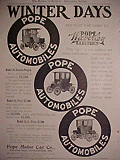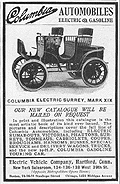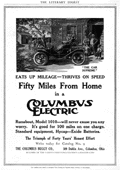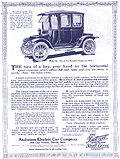|
"Why
did it take so long for Electric Vehicles to
compare to gasoline-powered vehicles?" For many
reasons the internal combustion engine made more
sense than electric motor.
Electrics
Almost Won at First: Gasoline powered vehicles,
while noisy and known to produce toxic emissions,
were considered a step up environmentally and in
community health from the prime competition in
transportation of the time - the horse. Horse
droppings were a major urban blight and public
health concern. They stank when fresh; attracted
disease-carrying flies; created a fine dust when
dry that caused respiratory problems and eye
irritation; and produced a slick, slippery, stinky
ooze when wetted down again by rain. Kind of
sounds like FUEL INDUCED SMOG!!!
The gasoline
powered car was recognized as imperfect even it its
early days. Popular Science reported in 1900 that
while gasoline cars ran well, they were "noisy, and
the odor of gasoline is disagreeable as well."
Still, they were such a step up from the
by-products of widespread use of horses, that the
marginal additional advantage of the electric drive
systems was not seen as signficant. Smog was
unknown. Environmental awareness as we know it
today was non-existent.




Electric cars
were just as fast as the gasoline cars of the
period. Electric cars held the world land speed
records from 1898 to 1902, beating out steam and
gasoline-powered vehicles. (When the record was
taken away from the electrics in 1902, it was not
by a gasoline-powered car, but by a steamer.) In
the early 1990's, one automotive executive from
Ford ridiculed the 1912 Baker Electric for having a
top speed of 35 mph, conveniently forgetting that
the Model T of the same vintage could not go any
faster - and the Model T had to back up many hills
because its gravity-fed fuel system would fail if
the rear-mounted fuel-tank ended up lower than the
engine while climbing the hill while going forward.
The Jenatzy achieved an officially recorded speed
of 106 km/h (about 66 mph) in 1899.

Road
Conditions: Roads at the end of the 1800's and
into the early 1900's were poor, often no more than
cartpaths, which is why virtually all vehicles of
the period shared the same high, narrow wheels of
the horse-drawn vehicles which were the main users
of those "roads". Without drainage or roadbeds,
spring thaws or even moderate rains were enough to
turn these rutted pathways into muddy sinkholes.
Electric cars, with their heavy loads of batteries,
were at a distinct disadvantage in these situations
which required being pulled, lifted and pried out
of these sinkholes.
Charging
Stations: Electrical generation facilities were
not standardized; some produced direct current (DC)
favoured by Edison; others produced alternating
current (AC) promoted by Westinghouse and Tesla -
with AC the eventual winner as the electrical grid
became standardized. Signficant rural
electrification did not even begin until the 1930's
in the U.S. and later in Canada. The majority of
the population before 1945 in North America was
rural. The move to urban centres and suburbia is a
post-war phenomenon. Urban populations demanded
long distance transportation in favor of the
gasoline powered internal-combustion engined
touring car.
Electricity
Pricing: Electricity was expensive and gasoline
was cheap. At the start of the 20th century,
electricity generally cost over 20 cents per kwh.
Gasoline could be had for 5 cents a gallon. In 1999
in Canada, electricity costs 10 cents per kwh
(about 40% of its price a century ago) and gasoline
is 60 cents per litre - more than $2.00 per gallon
(40 times its price a century ago).
Gasoline
Stations Generated Profits: Gasoline-powered
vehicles needed gasoline stations to refill. Before
1898, finding gasoline for a car was an adventure
in itself. By 1905, many general stores, carriage
shops, smithies and even liveries were keeping
large cans of gasoline on-hand to fuel the few
gasoline cars that came by. Business in gasoline
was not brisk initially, but it was lucrative -
those that could afford the cars could afford to
pay a premium for the gasoline. In 1905, 86% of the
cars sold in the U.S. were powered by gasoline ;
electric and steam held about 7% each. This is
eight years before the electric starter was
available on any gasoline-powered car. By 1914,
half the cars in North America were Model T's,
which had started production just six years
earlier. By 1920, the gasoline pumps were evident
throughout North America, before electrification
became a national initiative in Canada or the
United States, and long before the standardized and
interconnected electrical grid that we take for
granted today was in place. According to Chevron,
they built the first gasoline station in the U.S.
in 1913, which started a boom in the building of
these facilities until they were ubiquitous
throughout the U.S. by 1920. In 1916 alone, over
200 petroleum companies were established in the
U.S., which co-incides neatly with the decline of
the electric car.
The Auto
Industry was Run by Billionaires: The limited
range of battery powered vehicles; the low speed of
electric vehicles; and, the lack of electric
recharging stations created a barrier for EV's
which could not be survive in the ever growing
world of the "Petroleum Billionaires". They had the
public by the nose and they knew it. The "Perfect
Product" is a product that needs to be replaced
every week, gasoline is burned off and the customer
will come back week after week to replinish his
tank!
Limited
Range: The average car in North America in the
1990's is driven less than 12,000 miles per year
(19,000 kilometres). This comes out to an average
of about 32 miles per day (50 kilometres) per day,
well within the capabilities of a pre 2000 electric
vehicle. Many gas vehicles could have been replaced
by electric cars as early as 1995. However, the
public's dependency upon gas power, and the need
for large, gas guzzling SUV's influenced auto
manufacturers to not be "The First to Try Something
New". It was not until the early 00's that Hybrid
automobiles (Using gas & electric motors) could
resolve the range issues along with advances in
battery technology, and generic 100 volt charging
capabilities.

Summary of
the 20th Century: Cheap and readily available
gasoline as opposed to expensive electricity and a
fragmented electrical generating industry and
distribution network. Gasoline was effectively a
waste product of the petroleum industry at the turn
of the 20th century - it was often burned off at
the well-head to get to the desired product -
kerosene for lamps. Poor roads which put the
heavier electrics at a disadvantage. Finally, the
decision by Henry Ford to base the first
mass-produced and priced for the masses vehicle on
the gasoline engine instead of electric drive
(apparently after discussions with Thomas Edison).
Today, the situation has changed: electricity is
cheap relative to gasoline; the road system handles
relatively heavier vehicles without difficulty; and
smog is killing people.
|

